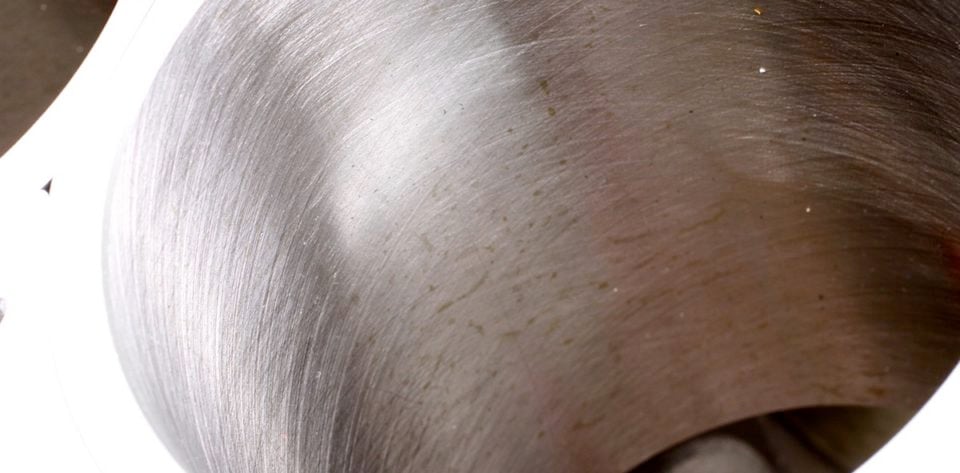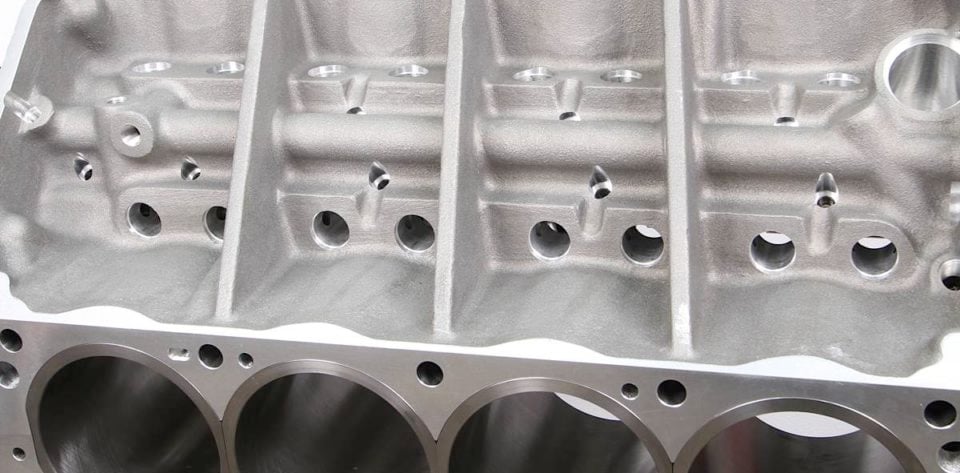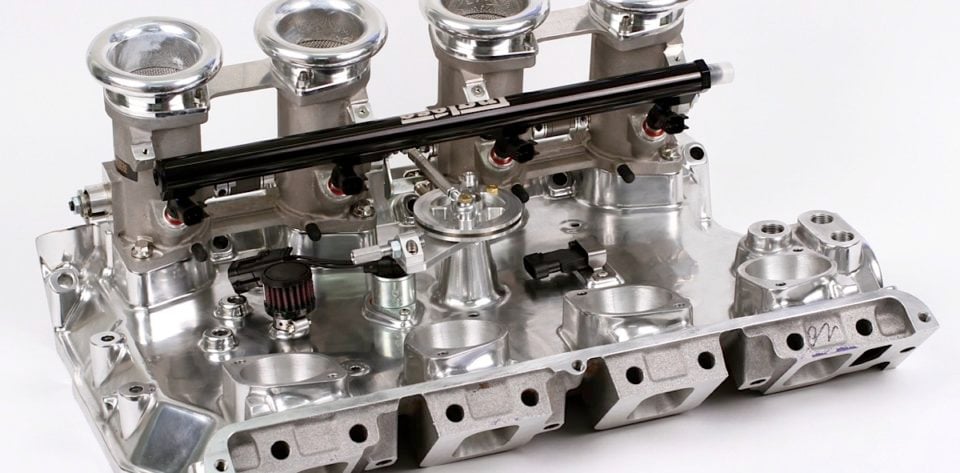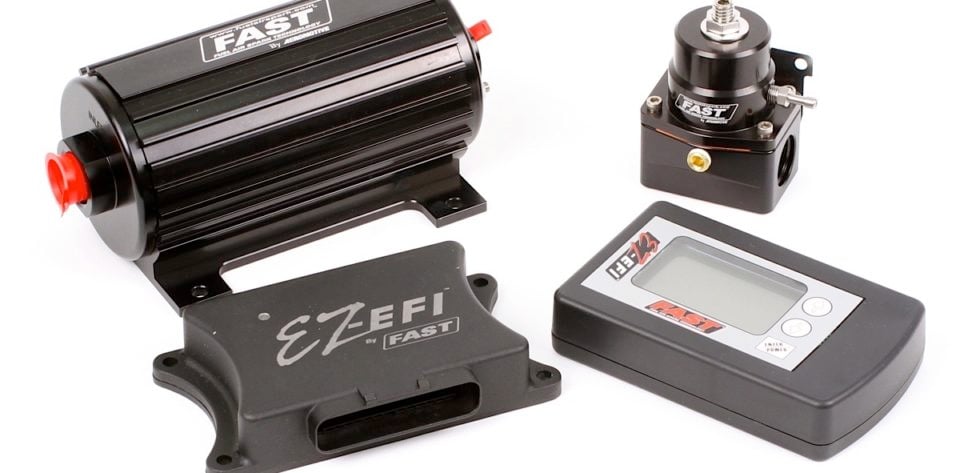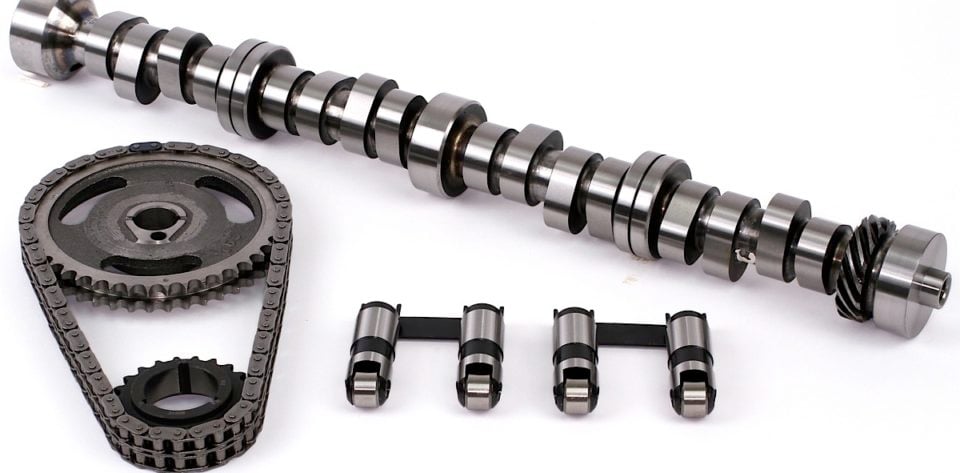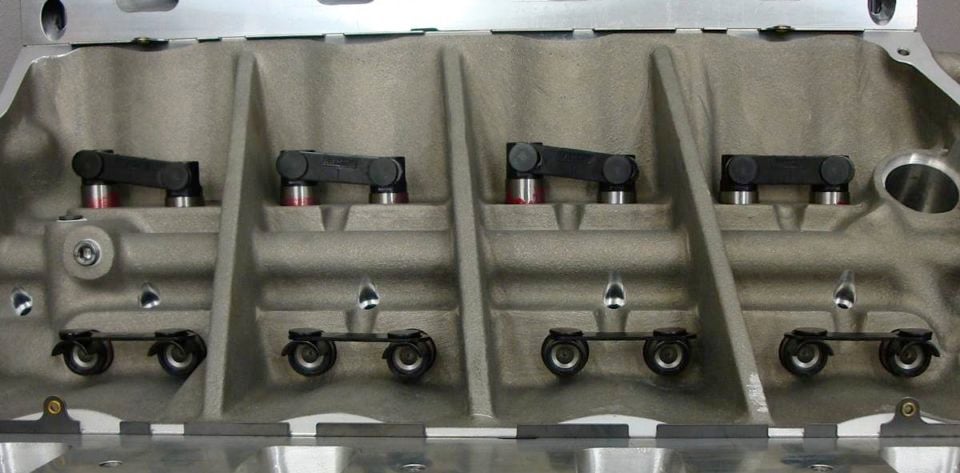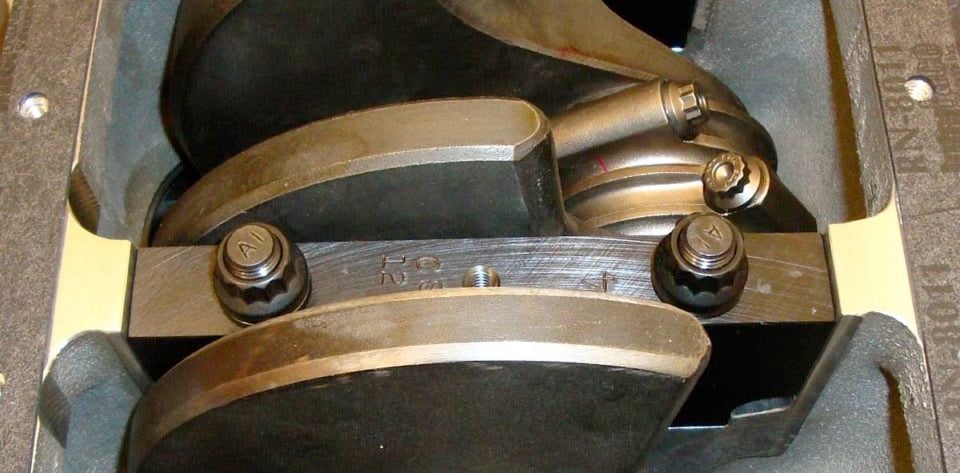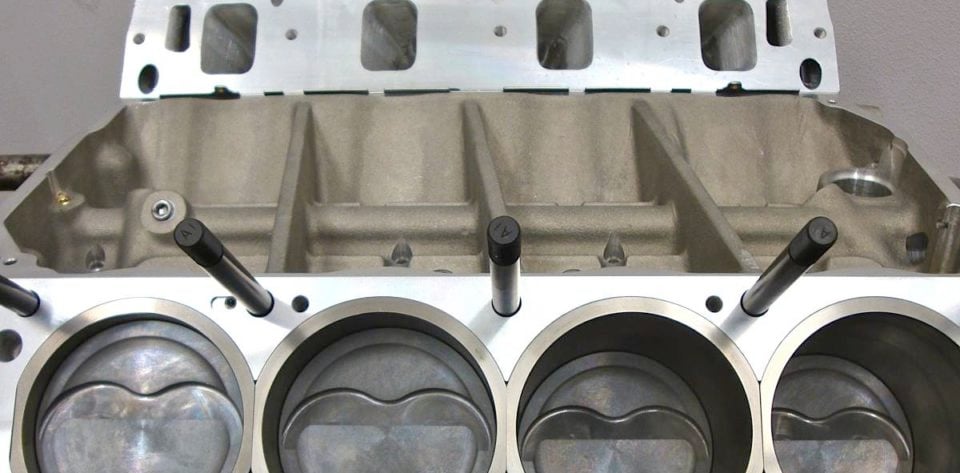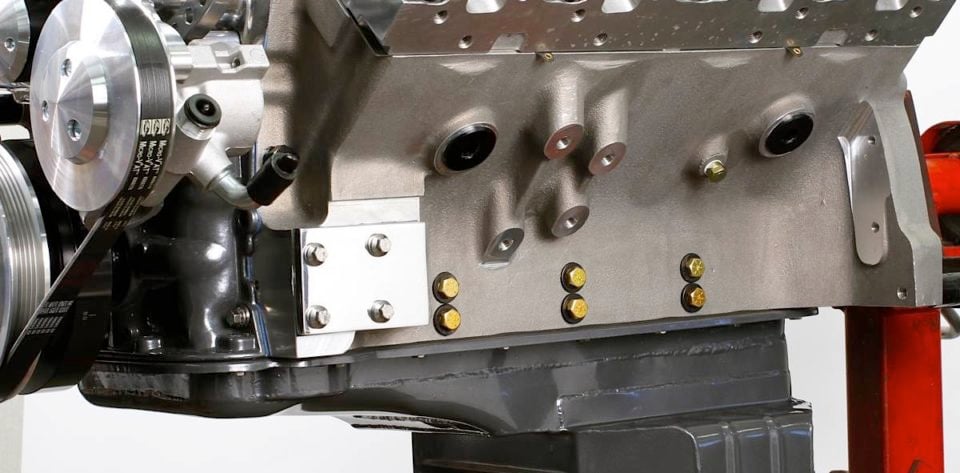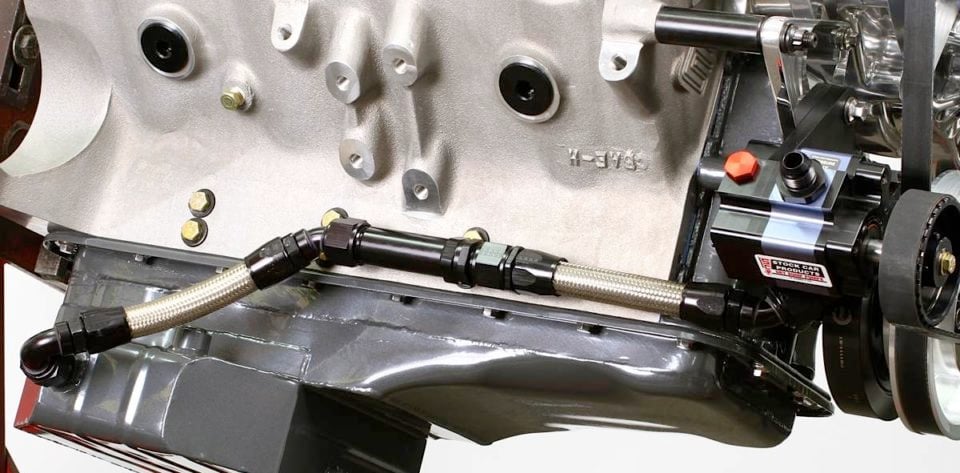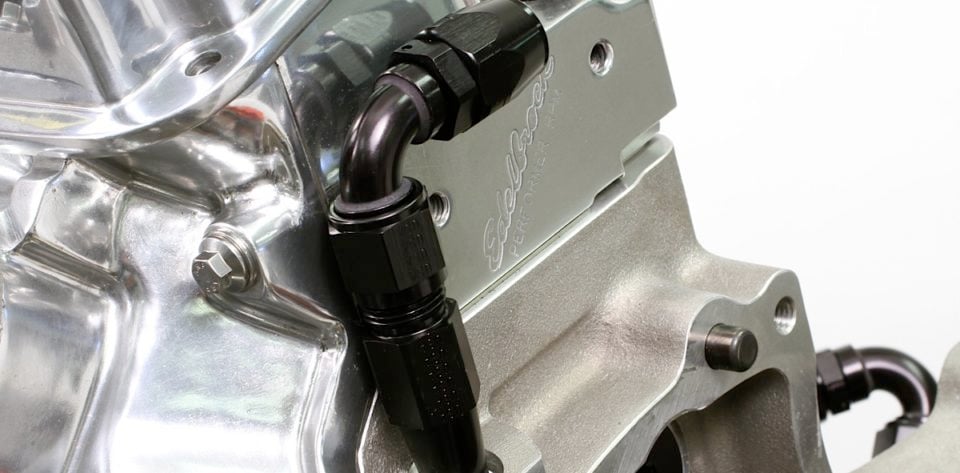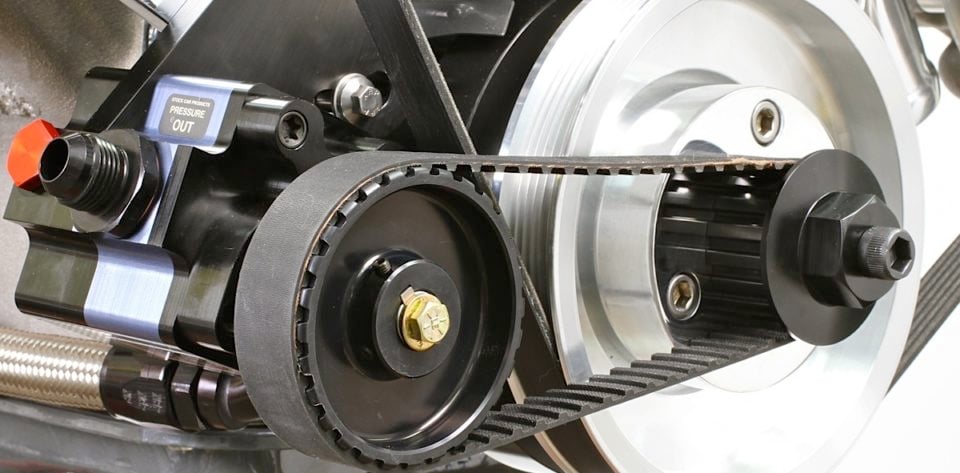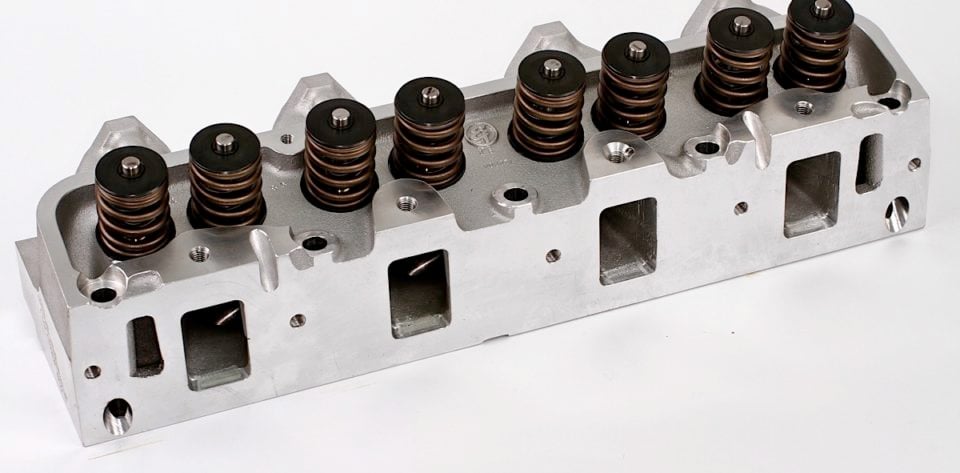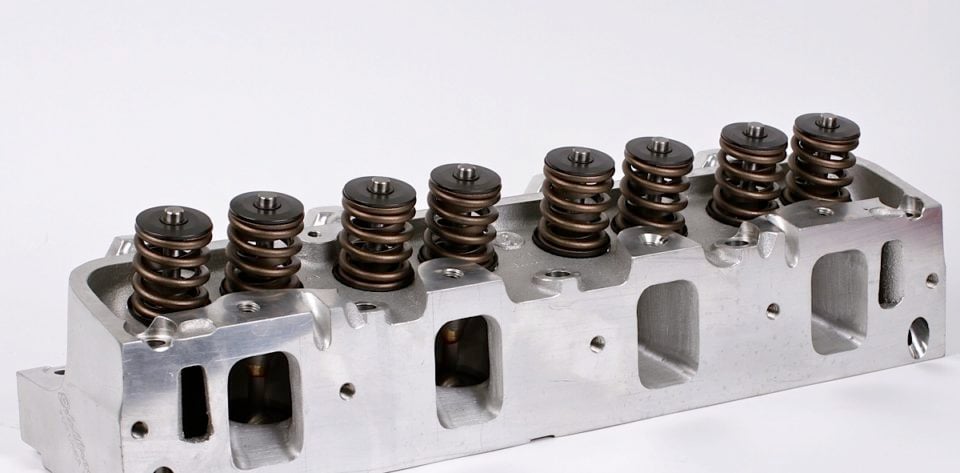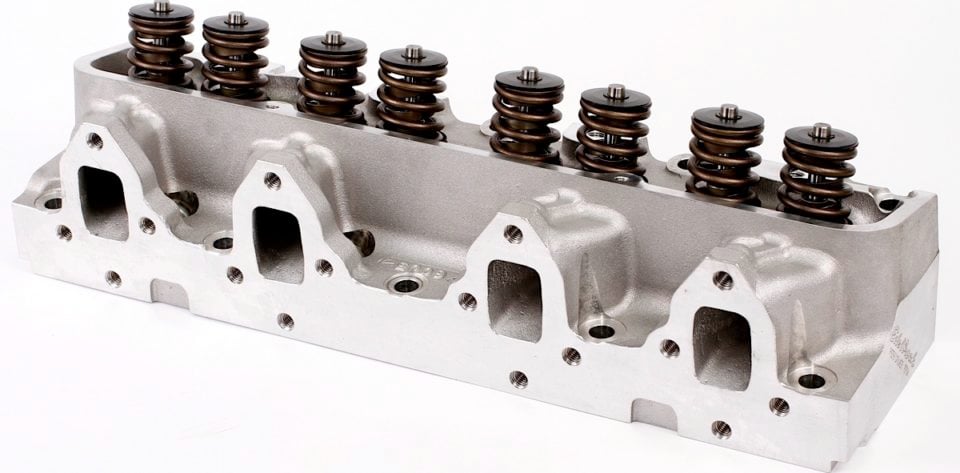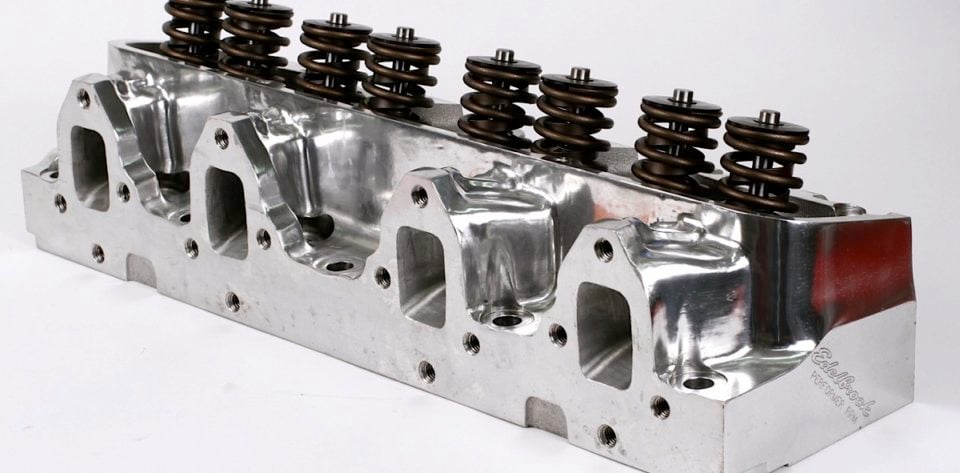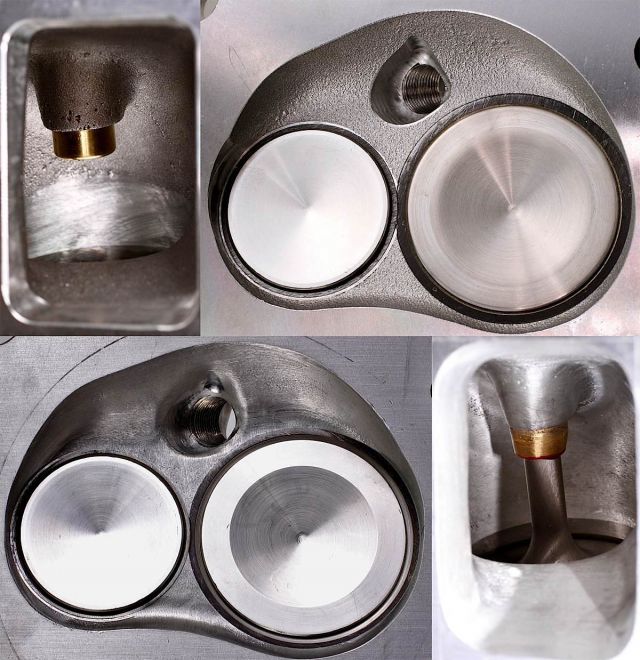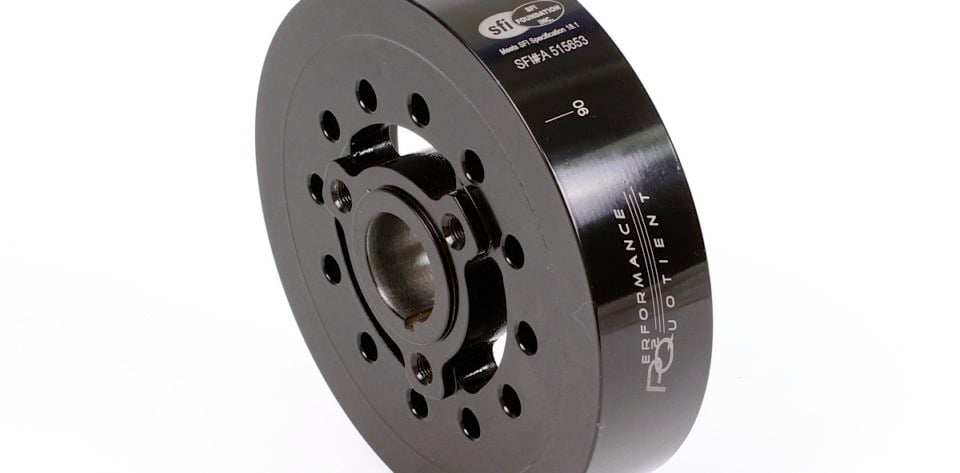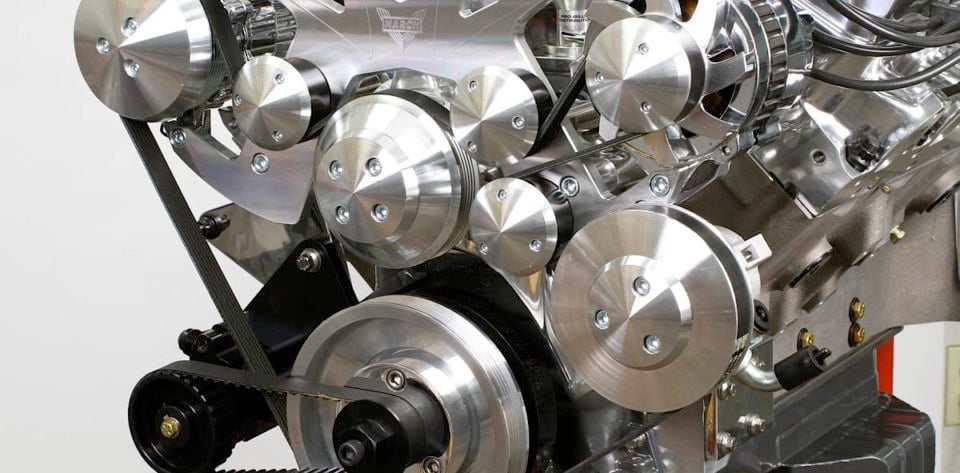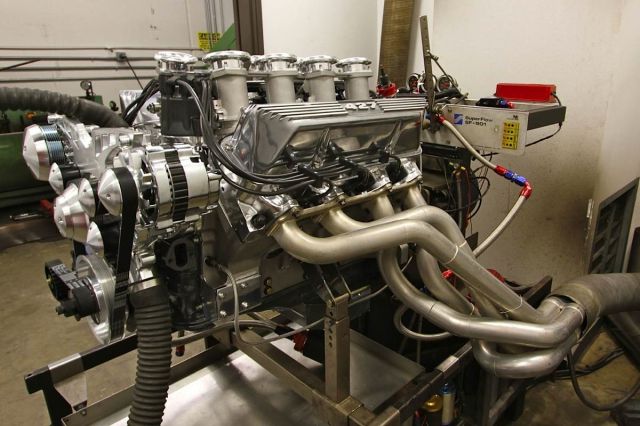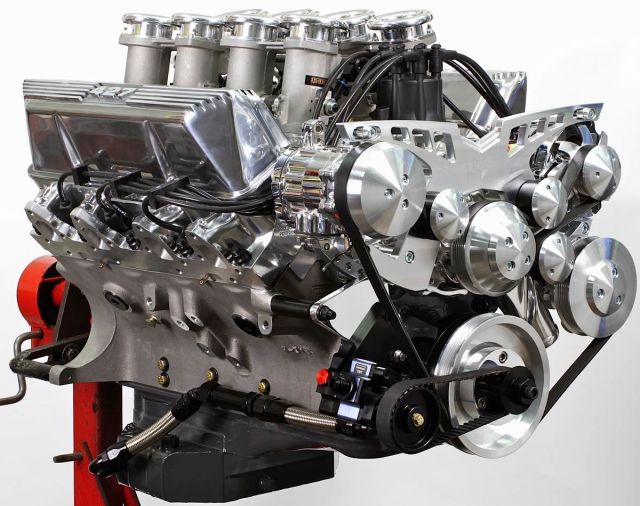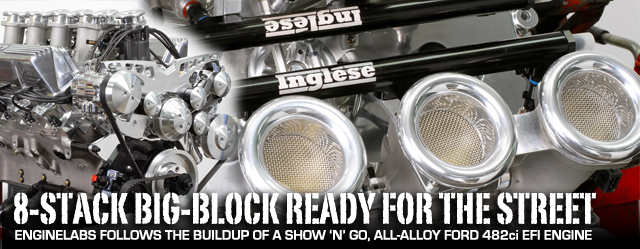 [1]Preserving a balance between exotic looks and streetable hosepower is now much easier with nostalgia-themed engine components, electronic fuel injection and advanced self-tuning programming controls.
[1]Preserving a balance between exotic looks and streetable hosepower is now much easier with nostalgia-themed engine components, electronic fuel injection and advanced self-tuning programming controls.
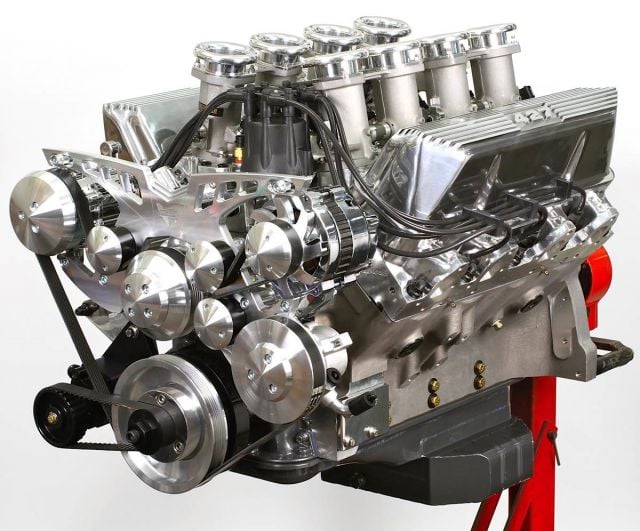 [2]When aftermarket EFI first became practical for performance street engines, builders started adapting the injectors to vintage Hilborn [3], Crower [4] and Enderle injector manifolds to achieve the gasser look with eight tall stacks of velocity tubes. Others played around with integrating EFI into old Weber down- and side-draft carbs to emulate a Sebring or LeMans road-race engine.
[2]When aftermarket EFI first became practical for performance street engines, builders started adapting the injectors to vintage Hilborn [3], Crower [4] and Enderle injector manifolds to achieve the gasser look with eight tall stacks of velocity tubes. Others played around with integrating EFI into old Weber down- and side-draft carbs to emulate a Sebring or LeMans road-race engine.
The objective was simply to add drivability to a classic engine induction, and that was the assignment given to Alan Bessant of BEP Performance [5] in Anaheim, California. The customer wanted a spirited Ford FE big-block to power a heavily customized 1961 Ford Thunderbird convertible.
The owner opted for a Shelby 427 FE block, which is about 45% lighter than the original factory block. It comes fully CNC finished and retains the original mounting bosses and bellhousing bolt pattern. Additional features include deep lifter valley with reinforced webs, thicker oil-pan rails and main webs, .750-inch thick deck and priority main oiling. BEP cleaned out the oil-return holes, added oil restrictors in select areas to control oil pressure and finished-honed the cylinders to 4.250.
Street manners
“The owner wanted to be able to drive to Las Vegas at any time,” explains Bessant. “He wanted all the accessories on the front drive. He didn’t want noise from the valvetrain since he also had plans for a premium stereo system in the car.”
Focal point for the 482 ci Ford big-block would be the new Inglese [10] 8-stack EFI manifold. Boasting the classic hot-rod look of a Weber 4×2 intake manifold, the Inglese hardware is supported by the EZ-EFI fuel injection system from FAST [11], resulting in an easy-to-install induction setup that delivers the nostalgic appearance of ‘60s Cobra big-block engines.
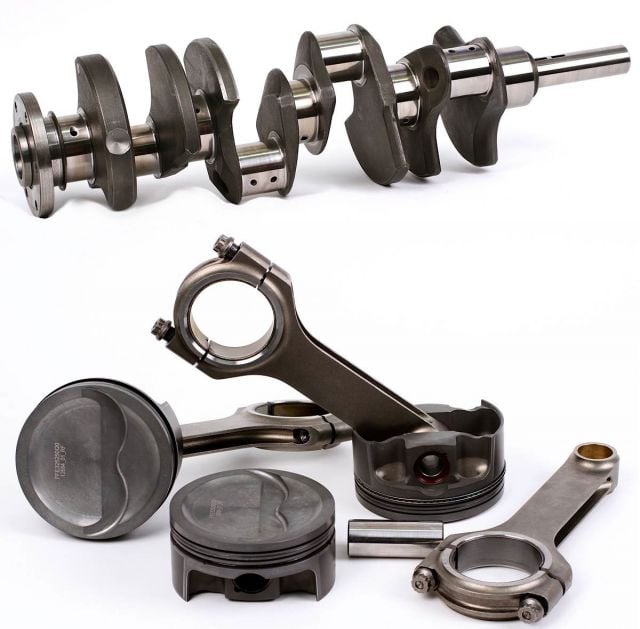 [12]
[12]Rotating assembly consists of a Scat 4.250-inch-stroke forged steel crankshaft, Scat 6.7-inch H-beam steel connecting rods and Mahle pistons with a 1.5mm, 1.5mm and 3.0mm ring package.
undefined
The Weber look
Weber carburetors provided the signature look to the Ford race engines of ’60s and ’70s, and Inglese worked with Weber on the Shelby Cobra and Ford GT-40s that ran on the great road-race circuits of the day. Today, Inglese emulates the classic Weber look with its series of 8-Stack manifolds and fuel-injection setups.
An aftermarket iron block was first chosen as the engine’s foundation, then the owner discovered the all-aluminum FE replacement from Carrol Shelby Engine Co [14]. Although a bit pricey, it comes fully CNC machined and retains all original mounting bosses and bellhousing bolt pattern. Overall the block is 45 percent lighter than a standard iron block, yet is stronger with reinforcing webs in the lifter valley and thick oil-pan rails. Other features include .750-inch deck, priority main oiling and billet-steel main caps.
“We didn’t have do much to the block,” says Bessant. “We cleaned up the drainback holes and torque-plate honed to 4.250 bore.”
Shown are views of the Inglese system before it’s fully assembled. Included in the kit are the FE manifold, 58mm throttle bodies, fuel rails, injectors, velocity stacks with integrated screens, linkage and all the necessary hardware. The pushrod holes on the intake manifold did require slight enlarging. The FAST EZ-EFI includes fuel pump, regulator, ECU and hand-held programmer. The owner had the velocity stacks polished and clear coated.
A little aggressive on the compression ratio
A Scat [19] forged-steel crankshaft with a 4.250-inch stroke is cradled by Clevite [20] bearings (about .0025-.0027 clearance). Scat 6.7-inch H-beam steel rods (with Chevy-sized 2.2-inch journals) are connected to phosphate-coated Mahle [20] pistons cut for 1.5mm, 1.5mm and 3mm rings. The entire rotating assembly was balanced at Revco Precision [21]. Compression ratio is slightly aggressive side at 10.5:1.
“We wanted to run it on pump fuel without a problem,” says Bessant. “The aluminum block and heads also let us set a little higher static compression.”
The Comp Cams hydraulic roller features specs of 230/236 at .050 duration, .521/532 lift, 112 lobe separation and it was installed at 108 on the intake. Rounding out the valvetrain are Comp lifters, pushrods and PRW shaft-mounted roller rockers with a 1.7:1 ratio. The double-roller timing chain is from Cloyes.
Assembly with Redline lube was straightforward. The Shelby block comes with billet steel main caps. Clearances for the Clevite bearings were set at .0025 to .0027. Cometic gaskets are used throughout the engine. Compression ratio was finalized at 10.5:1 with the Mahle pistons and Edelbrock heads.
The Milodon oil pan was sectioned about an inch below the rails so the sump could be rotated to the rear. The internal pickup is welded in place and leads to a -12AN scavenge line and filter. The single-stage external pump is from Stock Car Products and is mounted with a custom-fabricated and polished bracket. The drive mandrel for the belt drive was also custom made. A -10AN line will go from the pressure outlet to an external oil filter and then enter the engine through a rear-mounted inlet fitting. Note the polished block-off plate on the left side of the engine where the stock oil-filter mount was located.
The bottom side of the engine proved the most difficult step in the build. The ’61 T-bird received a rack-and-pinion steering and Mustang II suspension upgrade, so a stock front-sump oil pan wouldn’t fit. BEP modified a Milodon [32] pan by sectioning it about one inch below the pan rail. Rotating the sump to the rear and a little welding later, the pan was a perfect fit. But there’s no provision for a rear-mount oil pump as the distributor is up front.
“So we just went to an external Stock Car Products [33] oil pump,” says Bessant, noting that custom brackets had to the fabricated to mount the pump. “There’s an internal oil pickup that we welded to the inside of the pan.”
Building the top end
A -12 line and scavenge filter are used on the scavenge side of the pump. A -10AN line will be used on the pressure side from the pump to a remote oil filter and then to a feed line in the rear of the block. An oil-filter block-off plate was fabricated to cover up the stock location.
The Edelbrock [34] Performer RPM cylinder heads were given a “Stage II” hand-porting at BEP, then fitted with Manley [35] valves (2.09/1.66), Comp Cams dual 1.550-inch valve springs (140 lbs on the seat, 320 lbs open) and PRW [36] 1.7:1 rocker arms. The heads were also polished to match the other bling on the engine.
Before and after photos of the Edelbrock cylinder heads that were polished and mildly hand-ported. They were assembled with Manley stainless-steel valves and Comp 1.550-inch dual valve springs: 140-pound seat pressure and 320 pounds open.
It fired right up and continued to make air-fuel adjustments.
— Alan Bessant
Finishing up the long block are ARP [42] hardware, Cometic [43] gaskets, Cloyes [44] double-roller timing chain, Edelbrock water pump and PRW 7-inch damper. The Inglese induction was bolted on after the stacks were sent out for polishing and clear coating. Final assembly included a MSD [45] distributor, Racing Power Company [46] valve covers and fully polished March [47] accessory drive.
Even with the close tolerances from Inglese, the 8-Stack throttle bodies have to be dialed in and sychronized. BEP first used a feeler gauge to adjust the throttle plates, according to instructions, then utilized a UniSync tool to fine-tune the air bleeds. This tool helps balance the airflow between stacks by measuring the flow with a movable float in a pressure tube.
Additional parts on the FE engine include a PRI fluid-gel damper, MSD distributor and March serpentine drive with power-steering pump, A/C compressor and alternator.
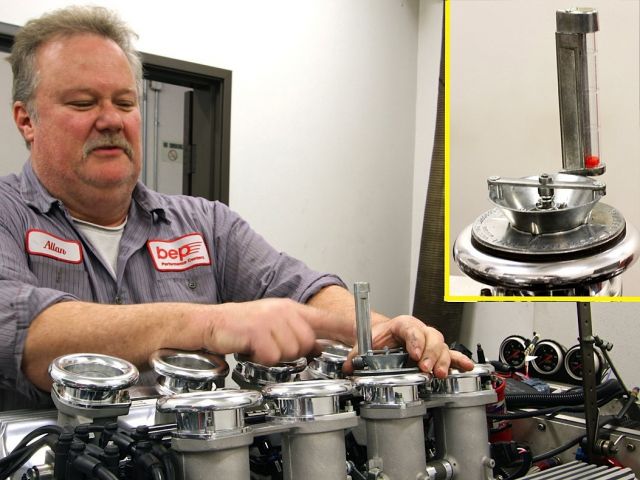 [51]
[51]Engine builder Alan Bessant uses the Uni Sync to check the airflow balance between the Inglese stacks.
The initial firing was uneventful as BEP programmed the necessary information into the Setup Wizard on the EZ-EFI controller. Idle was set at 850 rpm.
“Working with the FAST system was awesome,” says Bessant. “It fired right up and continued to make air-fuel adjustments as engine warmed up.”
Best pull on the Superflow [52] dyno was 546 horsepower at 5,900 rpm, and peak torque was measured at 547 lb-ft at 3,100 rpm. Bessant did note that the EZ-EFI controller doesn’t allow immediate air-fuel ratio changes at wide-open throttle. To help protect against drastic changes that could hurt the engine, the controller makes gradual changes following any adjustments to the basic calibrations. BEP ended up at 12.5:1 on the last pull.
“The cam is really mild,” says Bessant. “But it’ll pull 550 lb-ft of torque below 3,000 rpm all day long.”
BEP toyed with the ignition timing, building torque with 34-35 degrees and then losing horsepower at 38 degrees.
“Thirty-six degrees seemed to the sweet spot,” adds Bessant.
The engine met all the customer expectations with its combination of nostalgic flair and low-maintenance horsepower that will fit nicely in a customized ’60s vehicle.
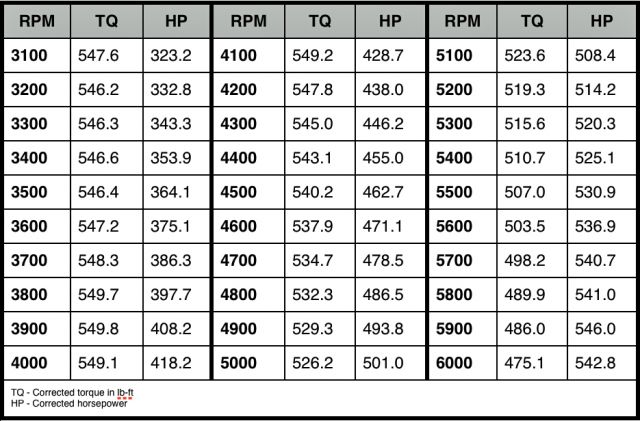 [54]
[54]BEP tests were conducted on a SuperFlow dyno. Top horsepower pull was 546 at 5,900 rpm with peak torque of 547 lb-ft at 3,100 rpm.

